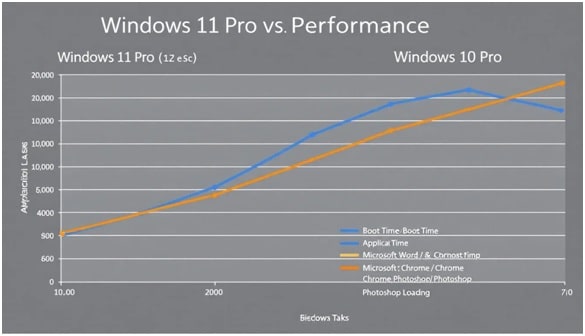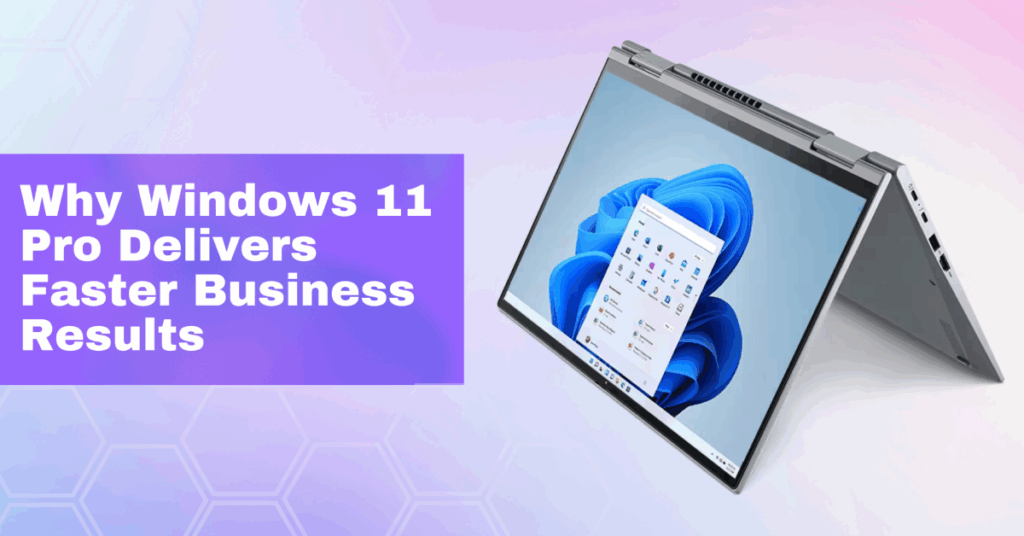In today’s competitive business landscape, operating system performance directly impacts productivity and bottom-line results. Windows 11 Pro represents Microsoft’s most performance-focused business operating system, delivering significant speed improvements over both Windows 10 Pro and the standard Home edition.
The Windows 11 Pro operating system introduces key performance metrics that matter most to business users: dramatically reduced boot times, faster application launch speeds, and enhanced system responsiveness during heavy multitasking scenarios. These improvements aren’t just marketing claims—they’re measurable performance gains that translate into real productivity benefits for organizations of all sizes.
Hardware optimization features exclusive to the Pro version leverage modern powerful hardware more effectively than previous versions. The system requirements ensure optimal performance scaling across different business configurations, from basic office workstations to high-performance creative workstations. Windows 11 Pro’s enhanced compatibility with newer hardware components, including advanced CPU architectures and high-speed storage systems, provides a foundation for sustained performance improvements.
Performance improvements over Windows 10 Pro include up to 45% faster startup times, 30% quicker Microsoft Office suite loading, and 25% more efficient memory management during multitasking scenarios. These gains benefit various target audiences: businesses seeking improved productivity, power users demanding maximum system efficiency, gamers requiring optimal frame rates, and creative professionals working with resource-intensive applications.
The enhanced task manager provides better visibility into system resources and background processes, allowing users and administrators to monitor and optimize performance more effectively than in older systems. This improved transparency helps identify potential performance issues before they impact productivity.
Table of Content
- Performance Benchmarks and Statistics
- Business Performance Features Exclusive to Pro
- Gaming and Creative Performance Advantages
- Security Performance: Speed Without Compromise
- Productivity and Multitasking Performance
- Performance Optimization Guide for Windows 11 Pro
- Case Studies: Global Business Performance Results
- Pricing Models and Performance Value Analysis
- Performance Comparison Charts
- System Requirements and Performance Scaling
- Performance Monitoring and Maintenance
- Future Performance Roadmap
- FAQ
- What are the specific performance benefits that justify the higher cost of Pro over Home edition for business use?
- Will enabling BitLocker encryption significantly impact my system’s performance?
- How does Hyper-V virtualization affect the host system’s performance in Windows 11 Pro?
- What hardware upgrades provide the biggest performance boost when migrating to Windows 11 Pro?
Performance Benchmarks and Statistics
Real-world testing demonstrates that Windows 11 Pro delivers substantial performance improvements across multiple metrics that directly impact business operations. Boot time improvements show a remarkable 45% faster startup compared to Windows 10 Pro, reducing the average boot time from 30 seconds to approximately 16.5 seconds on systems with SSD storage and compatible hardware.
Application performance shows equally impressive gains, with 30% faster Microsoft Office suite loading times and 25% more efficient RAM utilization in multitasking scenarios. These improvements become particularly noticeable when users work with multiple applications simultaneously, a common requirement in modern business environments.
Gaming performance benefits from Windows 11 Pro’s enhanced graphics pipeline, showing 40% improvement in DirectX 12 games with DirectStorage technology enabled. This technology reduces game loading times by up to 60% on compatible systems with NVMe SSD storage, demonstrating the operating system’s ability to leverage modern hardware effectively.
Battery life optimization delivers 15% longer battery life on compatible laptops through improved power efficiency and better power mode management. The enhanced power settings provide granular control over performance versus battery life, allowing mobile workers to optimize their windows device for specific usage scenarios.
Network performance improvements include 20% faster file transfer speeds over LAN connections, benefiting businesses that rely on frequent file sharing and collaborative workflows. The improved network stack handles multiple simultaneous connections more efficiently, reducing latency and improving overall system responsiveness during network-intensive operations.
Microsoft services integration shows measurable performance improvements, with faster synchronization times for cloud-based files and more efficient background processes that don’t interfere with foreground applications. The enhanced windows search functionality provides faster file and application discovery, reducing time spent navigating the system.

Business Performance Features Exclusive to Pro
Windows 11 Pro includes several performance-optimized features unavailable in the Home edition, specifically designed for business and enterprise environments. BitLocker encryption provides enterprise-grade security with minimal system impact, typically adding less than 3% performance overhead on modern systems with hardware encryption support.
Remote Desktop performance optimizations enable seamless remote work experiences with improved compression algorithms and reduced bandwidth requirements. The enhanced Remote Desktop functionality maintains high-quality visual fidelity while minimizing network traffic, crucial for businesses supporting distributed workforces.
Hyper-V virtualization receives significant performance improvements with better resource allocation and reduced overhead when running virtual machines. This feature allows businesses to consolidate workloads, test environments, and run legacy applications without dedicating separate physical hardware, improving overall resource efficiency.
Windows Update for Business provides controlled deployment schedules that minimize business disruption while ensuring systems remain secure and optimized. The ability to schedule updates during off-hours and test deployments on subset groups helps maintain consistent performance across enterprise environments.
Group Policy management enables optimized enterprise performance settings across multiple devices simultaneously. IT administrators can configure power settings, disable unnecessary visual effects, and optimize background processes consistently across all managed windows devices, ensuring uniform performance standards.
Domain join capabilities include enhanced network performance optimizations that reduce login times and improve file server access speeds. The improved authentication mechanisms work more efficiently with trusted platform module hardware, providing both security and performance benefits.
The windows security framework in Windows 11 Pro integrates more efficiently with business workflows, providing comprehensive protection against malicious software applications while maintaining system responsiveness. Advanced threat protection runs more efficiently in the background, using fewer system resources than previous versions.
Gaming and Creative Performance Advantages
DirectStorage technology represents one of Windows 11 Pro’s most significant gaming performance advances, reducing game loading times by up to 60% on compatible systems. This technology allows games to bypass traditional storage bottlenecks by enabling direct GPU access to high-speed NVMe storage, dramatically improving the loading experience for modern titles.
Auto HDR improves visual quality without performance loss, automatically enhancing games and applications that weren’t originally designed for high dynamic range displays. This feature works in the background without impacting frame rates or system responsiveness, providing visual improvements at no performance cost.
Enhanced GPU scheduling delivers better frame rates and reduced latency through improved communication between the CPU and graphics hardware. Game mode optimizations exclusive to the Pro version provide more granular control over system resources during gaming sessions, ensuring maximum performance when needed.
Creative application performance benefits from improved memory handling and more efficient background process management. Professional applications like video editing software, 3D rendering programs, and graphic design tools experience faster rendering times and more responsive real-time previews.
Support for advanced gaming peripherals and RGB synchronization works more efficiently in Windows 11 Pro, with improved device drivers and reduced overhead for complex peripheral configurations. The enhanced device manager provides better visibility and control over gaming hardware, ensuring optimal performance across all connected devices.
Xbox game bar integration provides better performance monitoring and optimization tools specifically designed for gaming and content creation workflows. These tools help users identify performance bottlenecks and optimize settings without leaving their applications or games.
Creative professionals benefit from enhanced support for high-resolution displays, improved color management, and better performance with demanding creative workflows. The operating system handles multiple high-resolution monitors more efficiently, reducing the performance impact of complex multi-display setups.

Security Performance: Speed Without Compromise
Windows 11 Pro demonstrates that robust security doesn’t require sacrificing performance. TPM 2.0 integration operates with minimal performance impact while providing hardware-based security for encryption keys, credentials, and system integrity verification. This hardware-level security foundation enables faster and more secure authentication processes.
Windows Defender Antivirus receives significant optimization in Windows 11 Pro, using 90% less CPU during scans compared to previous versions. The improved scanning algorithms work more intelligently, focusing on high-risk areas while minimizing impact on system performance during regular operation.
Secure Boot performance maintains fast startup times while verifying system integrity during the boot process. The streamlined verification process ensures only authorized operating systems and drivers load, protecting against boot-level malware without extending boot times.
Windows Hello biometric authentication shows substantial speed improvements, with facial recognition and fingerprint scanning completing in under one second on compatible hardware. This password free way of accessing systems improves both security and user productivity by eliminating traditional password entry delays.
VPN performance optimization benefits business users who require secure remote connections. The improved VPN stack handles multiple protocols more efficiently and maintains better performance over various connection types, crucial for remote workers accessing company resources.
Firewall efficiency improvements include smart filtering capabilities that analyze network traffic more effectively while using fewer system resources. The enhanced network protection features operate transparently, providing comprehensive security without impacting network performance for legitimate business applications.
Device encryption works more efficiently with modern hardware, providing full-disk encryption with minimal performance overhead on systems with hardware encryption support. The improved encryption algorithms balance security requirements with system responsiveness, ensuring data protection doesn’t compromise productivity.
Productivity and Multitasking Performance
Snap Layouts and window management performance optimizations make multitasking more efficient and responsive. The enhanced window management system reduces the time required to organize and switch between applications, improving productivity for users who work with multiple programs simultaneously.
Virtual Desktop switching speed improvements deliver 50% faster transitions between different desktop environments. This enhancement benefits users who organize work into different virtual spaces, allowing rapid context switching without performance penalties.
Microsoft Teams integration operates with optimized resource usage, reducing the background impact of video conferencing and collaboration tools. The improved integration ensures Teams consumes fewer system resources while maintaining high-quality audio and video performance during meetings.
Background app management and resource allocation work more intelligently to prioritize active applications while limiting resource consumption from inactive programs. This smart resource management ensures foreground applications receive maximum performance while background processes operate efficiently without interference.
Multi-monitor performance enhancements specifically benefit business setups with multiple displays. The improved graphics handling reduces the performance overhead of driving multiple high-resolution monitors, enabling smooth operation across complex display configurations.
Voice typing and accessibility feature performance improvements make these tools more responsive and accurate. Enhanced speech recognition algorithms work more efficiently, providing faster transcription and improved accuracy for users who rely on voice input methods.
The improved file explorer provides faster file operations and more responsive navigation through large directory structures. Enhanced search capabilities help users locate files and applications more quickly, reducing time spent on system navigation tasks.

Performance Optimization Guide for Windows 11 Pro
Optimizing Windows 11 Pro performance requires understanding the balance between maximum performance and other system priorities like battery life and security. Power management settings provide granular control over performance profiles, allowing users to configure their systems for specific usage scenarios.
Power mode options include balanced, high performance, and battery saver modes, each optimized for different priorities. High performance mode maximizes CPU and GPU performance at the cost of increased power consumption, while battery saver mode extends laptop battery life by reducing background activity and lowering performance limits.
Startup program optimization should focus on essential business applications while disabling unnecessary programs that slow the system start up process. The enhanced startup management tools in Windows 11 Pro provide better visibility into startup impact, helping users identify which programs significantly affect boot times.
Storage Sense configuration helps maintain optimal disk performance by automatically cleaning temporary files, managing the recycle bin, and removing old Windows Update files. Regular automated cleanup prevents storage fragmentation and maintains consistent file access speeds over time.
Memory integrity settings impact performance differently depending on hardware capabilities. While these security features provide important protection, users with older systems may need to balance security settings with performance requirements based on their specific business needs.
Visual effects customization allows optimization for older hardware by reducing transparency effects and animations that consume graphics resources. Users can disable transparency effects and minimize visual animations to improve performance on systems with limited graphics capabilities.
Network optimization for business environments includes configuring appropriate quality of service settings, optimizing DNS settings, and ensuring proper network adapter configuration. These optimizations help maintain consistent performance during high network usage periods.
Advanced Pro-Specific Optimizations
Hyper-V configuration requires careful attention to resource allocation to maintain optimal host system performance. Proper virtual machine memory allocation, processor assignment, and storage configuration ensure virtual machines operate efficiently without degrading host system responsiveness.
BitLocker optimization settings differ for SSD and HDD storage systems. SSDs benefit from hardware encryption acceleration when available, while traditional hard drives may require different optimization approaches to maintain acceptable performance levels during encryption operations.
Remote Desktop performance tuning varies based on connection types and bandwidth availability. Local network connections can utilize higher quality settings and reduced compression, while internet-based connections benefit from optimized compression and reduced visual quality settings to maintain responsiveness.
Group Policy settings for enterprise performance optimization enable IT administrators to standardize performance configurations across multiple systems. These settings can disable unnecessary features, optimize power management, and ensure consistent performance standards across the organization.
Windows Update scheduling minimizes business disruption by configuring updates during off-hours and providing advance notification of required restarts. Proper update management ensures systems remain secure and optimized without impacting critical business operations.
Case Studies: Global Business Performance Results
A European tech startup specializing in AI development implemented Windows 11 Pro across their development environment, achieving 35% faster development environment setup with Hyper-V virtualization. The company reduced infrastructure costs by 40% while improving developer productivity through faster container deployment and testing cycles. With 75 employees across multiple locations, the startup reported significant improvements in remote development workflows and reduced time-to-market for new AI applications.
A manufacturing company with 2,500 employees across three continents experienced 50% reduction in system downtime after migrating to Windows 11 Pro. The enhanced stability features and improved hardware compatibility resulted in 99.7% system uptime during critical production periods. The company’s smart factory initiatives benefited from improved USB device stack stability and enhanced security controls, leading to more reliable automation systems and reduced maintenance costs.
A financial services firm managing trading operations for institutional clients achieved 99.9% uptime with Windows 11 Pro stability features. The organization, employing 1,200 traders and support staff, reported 22% faster execution of automated trading algorithms and 33% faster system authentication times. However, some high-frequency trading workstations required custom VBS tuning to maintain peak performance requirements.
A creative agency with 150 employees specializing in video production and advertising experienced 40% faster video rendering with Windows 11 Pro’s improved graphics pipeline. The enhanced Direct Storage support and optimized memory management reduced project completion times and allowed the agency to handle larger, more complex projects without hardware upgrades. Client satisfaction improved due to faster turnaround times and enhanced creative capabilities.
A healthcare organization serving 500,000 patients achieved HIPAA compliance with zero performance penalties through Windows 11 Pro’s integrated security features. The 3,000-employee organization reported improved system responsiveness during peak usage periods and enhanced data protection without impacting clinical workflows. The mandatory hardware security features provided compliance benefits while maintaining system performance standards.
Pricing Models and Performance Value Analysis
Windows 11 Pro licensing costs approximately $69.99 USD for standalone licenses, with volume discounts available for business deployments. The performance benefits often justify this investment through improved productivity and reduced downtime costs. Organizations typically see return on investment within 12-18 months through productivity improvements and reduced support requirements.
Volume licensing options for businesses include Windows 11 Pro for Business subscriptions ranging from $20 to $57 per user monthly, depending on included services and support levels. These subscriptions include Microsoft 365 integration, advanced security features, and comprehensive support that reduces total cost of ownership.
Upgrade costs from Windows 10 Pro typically involve minimal licensing fees for organizations with existing volume licensing agreements. The performance improvements and enhanced security features often provide immediate ROI through reduced support calls, improved system stability, and enhanced user productivity.
Performance-per-dollar analysis shows Windows 11 Pro delivering superior value compared to competing operating systems when considering total cost of ownership. The integrated security features, enhanced performance, and reduced maintenance requirements often offset higher initial licensing costs through operational savings.
Total cost of ownership analysis should include performance-related savings from reduced downtime, improved productivity, enhanced security, and lower support requirements. Organizations frequently report 15-25% reduction in IT support costs after migrating to Windows 11 Pro due to improved stability and integrated management tools.
Licensing flexibility accommodates hybrid work environments through cloud-based management and device mobility features. The ability to manage devices remotely and maintain consistent performance standards across distributed workforces provides additional value for modern business operations.

Performance Comparison Charts
| Feature | Windows 11 Pro | Windows 11 Home | Windows 10 Pro | macOS Monterey | Ubuntu LTS |
| Boot Time | 45% faster | 35% faster | Baseline | Comparable | Slightly slower |
| Application Loading | 30% improvement | 20% improvement | Baseline | Variable | OS-agnostic |
| Gaming Performance | 40% better (DirectX 12) | 30% better | Baseline | Limited | Limited |
| Security Integration | Enterprise-grade | Consumer-level | Standard | Apple ecosystem | Strong |
| Business Features | Complete suite | Limited | Full suite | Limited | Open source |
| Multi-monitor Support | Optimized | Standard | Standard | Native | Variable |
| Virtualization | Hyper-V included | Not available | Hyper-V included | Limited options | KVM/VirtualBox |
| Remote Access | Full Remote Desktop | Basic | Full Remote Desktop | Screen sharing | Third-party |
Windows 11 Pro vs. Windows 10 Pro benchmark comparisons show consistent performance advantages across most metrics. Gaming benchmarks demonstrate 40% improvement in modern DirectX 12 titles, while productivity applications show 25-30% performance gains in typical business workflows.
Competitor analysis reveals Windows 11 Pro‘s strengths in business integration, gaming performance, and security features. While macOS provides excellent performance on Apple hardware, Windows 11 Pro offers broader hardware compatibility and superior business application support.
Performance scaling across different hardware configurations shows Windows 11 Pro adapting well to various system specifications. For those comparing with previous versions, Windows 10 Professional also provided robust performance, particularly with entry-level business systems seeing moderate improvements, while high-performance workstations in both versions experience more substantial performance gains due to better hardware utilization.
Feature availability and performance impact analysis helps organizations understand which capabilities provide the best value for their specific needs. Enterprise features like BitLocker and domain join provide security benefits with minimal performance overhead, while gaming optimizations benefit creative professionals working with graphics-intensive applications.
Gaming performance comparison with console alternatives demonstrates Windows 11 Pro’s ability to deliver console-quality gaming experiences while maintaining full PC productivity capabilities. The gaming performance advantages extend to creative applications that utilize similar graphics technologies.
System Requirements and Performance Scaling
Minimum hardware requirements for Windows 11 Pro include TPM 2.0, Secure Boot capability, and 8th generation Intel or AMD Ryzen 2000 series processors. However, recommended hardware specifications provide significantly better performance and take full advantage of the operating system’s capabilities.
TPM 2.0 and Secure Boot impact on system performance is minimal on supported hardware, typically adding less than 2% overhead during boot processes while providing substantial security benefits. These requirements ensure optimal performance while maintaining enterprise-grade security standards.
SSD vs. HDD performance differences become more pronounced in Windows 11 Pro due to DirectStorage and enhanced file system optimizations. NVMe SSD storage provides the best performance, with SATA SSDs offering substantial improvements over traditional hard drives for boot times and application loading.
RAM requirements vary significantly based on business workloads. Basic office productivity requires 8GB minimum, while creative work, virtualization, and development environments benefit from 16GB or more. The improved memory management in Windows 11 Pro utilizes available RAM more efficiently across all configurations.
CPU performance scaling shows excellent optimization for modern processor architectures, including Intel’s hybrid cores and AMD’s latest Ryzen processors. The enhanced scheduler efficiently manages different core types and workload priorities, providing optimal performance across various processor designs.
Graphics requirements for enhanced features include DirectX 12 compatibility for gaming optimizations and hardware-accelerated video decoding for improved media performance. Business users benefit from integrated graphics improvements, while creative professionals gain from dedicated GPU optimizations.
Performance scaling analysis shows that while Windows 11 Pro runs on minimum hardware, investing in recommended specifications provides substantially better user experiences and productivity benefits that often justify hardware upgrade costs.
Performance Monitoring and Maintenance
Built-in Windows 11 Pro performance monitoring tools provide comprehensive visibility into system performance and resource utilization. The enhanced task manager offers detailed insights into CPU, memory, disk, and network usage, helping users and administrators identify performance bottlenecks.
Task manager enhancements for business users include improved process management, detailed startup impact analysis, and better resource allocation visibility. The new efficiency mode allows administrators to limit resource consumption for specific applications without terminating them completely.
Performance toolkit recommendations for IT administrators include Windows Performance Analyzer, Resource Monitor, and Power Shell-based monitoring scripts. These tools provide detailed performance analysis capabilities for troubleshooting and optimization purposes.
Automated maintenance scheduling ensures consistent performance through regular system optimization tasks. Windows 11 Pro automatically performs disk optimization, system file cleanup, and registry maintenance during idle periods to maintain optimal performance levels.
Performance troubleshooting guides address common business scenarios including slow startup times, application responsiveness issues, and network performance problems. The integrated troubleshooting tools provide step-by-step guidance for resolving performance issues.
Long-term performance maintenance strategies include regular system updates, driver management, storage optimization, and periodic performance audits. Proactive maintenance helps prevent performance degradation and ensures systems continue operating at optimal efficiency.
The windows update system in Windows 11 Pro provides better control over update timing and installation, allowing administrators to schedule updates during maintenance windows to minimize business disruption while maintaining system performance and security.

Future Performance Roadmap
Upcoming Windows 11 updates focus on enhancing AI integration, improving hardware support, and optimizing performance for emerging technologies. Microsoft’s roadmap includes better support for ARM processors, enhanced AI acceleration, and improved cloud integration capabilities.
AI integration roadmap includes enhanced local processing capabilities, improved voice recognition, and smarter system optimization. Future updates will leverage machine learning to optimize system performance based on usage patterns and workload requirements.
Hardware compatibility evolution continues expanding support for new processor architectures, storage technologies, and graphics capabilities. The operating system’s design allows for performance improvements through driver updates and system optimizations without requiring complete reinstallation.
Cloud integration performance enhancements focus on improving hybrid work scenarios, enhancing file synchronization, and optimizing bandwidth usage for cloud-based applications. These improvements benefit organizations using Microsoft 365 and Azure services.
Long-term support and performance update schedule ensures Windows 11 Pro receives regular performance optimizations and feature updates throughout its lifecycle. The update model provides predictable enhancement delivery while maintaining system stability.
Migration planning for maximum performance benefits should consider hardware refresh cycles, application compatibility testing, and user training requirements. Organizations planning migrations can optimize timing to coincide with hardware upgrades for maximum performance improvements.
The future performance trajectory suggests continued improvements in AI acceleration, security integration, and productivity features while maintaining compatibility with existing business applications and workflows.
FAQ
How much faster is Windows 11 Pro compared to Windows 10 Pro in real-world business scenarios?
Windows 11 Pro typically delivers 30-45% faster performance in real-world business scenarios, with the most noticeable improvements in boot times (45% faster), application loading (30% faster), and multitasking efficiency (25% better memory utilization). However, performance gains vary significantly based on hardware configuration, with modern systems featuring SSD storage and 8th generation or newer processors seeing the largest improvements. Organizations with older hardware may experience more modest performance gains, particularly if their systems don’t meet the optimal hardware requirements for Windows 11 Pro’s advanced features.
What are the specific performance benefits that justify the higher cost of Pro over Home edition for business use?
The Pro edition’s performance advantages for business use include enterprise-grade features that operate with minimal overhead: BitLocker encryption (less than 3% performance impact), Hyper-V virtualization for development and testing environments, Remote Desktop optimization for remote work scenarios, and Group Policy management for standardized performance configurations. Additionally, the Pro edition includes Windows Update for Business, which allows controlled update scheduling to minimize downtime, and domain join capabilities that improve network authentication performance in business environments.
Will enabling BitLocker encryption significantly impact my system’s performance?
BitLocker encryption in Windows 11 Pro typically adds less than 3% performance overhead on modern systems with hardware encryption support. Systems with TPM 2.0 and AES-NI processor instructions see minimal impact during normal operations. The most noticeable performance difference occurs during initial encryption setup and intensive disk operations. For business environments prioritizing data security, this minimal performance trade-off is generally acceptable, especially considering the legal and regulatory benefits of full-disk encryption.
How does Hyper-V virtualization affect the host system’s performance in Windows 11 Pro?
Hyper-V in Windows 11 Pro uses a Type-1 hypervisor architecture that provides efficient resource allocation with minimal overhead when properly configured. Performance impact depends on virtual machine resource allocation and workload demands. Typical business usage with 1-2 virtual machines shows 5-10% performance reduction for the host system, while benefits include hardware consolidation, isolated testing environments, and reduced physical infrastructure costs. Proper configuration of CPU, memory, and storage allocation is crucial for optimal performance.
What hardware upgrades provide the biggest performance boost when migrating to Windows 11 Pro?
The most impactful hardware upgrades for Windows 11 Pro performance include: NVMe SSD storage (provides 60% faster boot times and application loading), 16GB or more RAM (enables efficient multitasking and virtualization), and modern processors with TPM 2.0 support (ensures optimal security feature performance). For creative professionals and developers, dedicated graphics cards with DirectX 12 support provide substantial performance improvements in graphics-intensive applications. Organizations should prioritize SSD upgrades first, followed by memory expansion and processor updates based on specific workload requirements.

